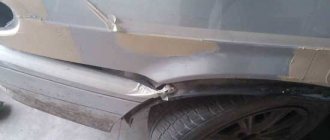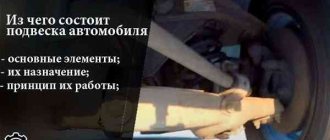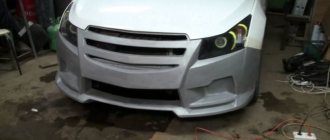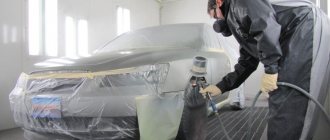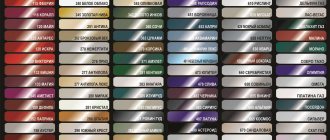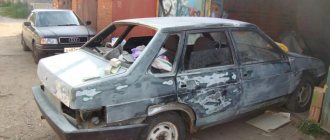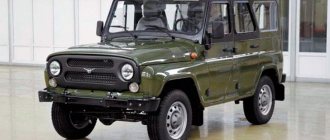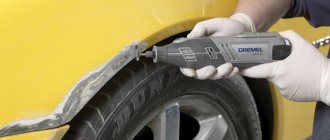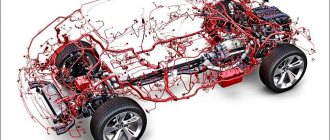Comments: no Published: 07/07/2017
Rating:
A car is a technically complex device consisting of a large number of parts, assemblies and mechanisms. Every self-respecting car owner is obliged to understand them, not even in order to be able to independently fix any malfunction that may arise on the road, but simply to understand the principle of operation of his car, and the ability to explain the essence of the problems that have arisen in a language understandable to a specialist. To do this, you need to know at least the basics, what main parts the car consists of, and what each part is called correctly.
See also:
Car muffler device
Car body
The basis of any car is its body, which is the body of the car that houses the driver, passengers and cargo. It is in the body that all other elements of the car are located. One of its main purposes is to protect the people and cargo in it from the influence of the external environment.
The supporting system of the car. It is the skeleton of the car, to which all the parts are subsequently attached.
Usually the body is attached to the frame, but there are also cars with a frameless design, and then the body simultaneously performs the functions of the frame. The car body structure is:
- single-volume, when the engine, passenger and cargo compartments are located in one volume (an example would be minivans or vans);
- two-volume, in which the engine compartment is provided, and places for passengers and cargo are combined in one volume (station wagons, hatchbacks, crossovers and SUVs);
- three-volume, where there are separate compartments for each part of the car body - cargo, passenger and engine (pick-ups, sedans and coupes).
Depending on the nature of the load, the body can have three types:
- carrier;
- semi-supporting;
- unloaded.
By the way, we would like to remind you that for cars and not only you can inexpensively buy interesting things on Aliexpress.
Most modern passenger cars have a supporting structure that absorbs all the loads acting on the car. The general structure of a passenger car body includes the following basic elements:
- spars, which are load-bearing beams in the form of a rectangular profile pipe, they are front, rear and roof spars;
Body load-bearing system. This system allows you to reduce the weight of the vehicle, lower the center of gravity, and therefore increase driving stability.
- pillars - structural elements that support the roof (front, rear and middle);
- beams and cross members, which are located at the roof, side members, under the engine mounts, and each row of seats, there is also a front cross member and a radiator cross member;
- thresholds and floors;
- wheel arches.
See also:
Car spar
Body layout
The load-bearing part of the car can consist of a frame and body, only the body, or be combined. The body that acts as a load-bearing part is called a load-bearing body. This type is most common on modern cars.
Also, the body can be made in three volumes:
- single-volume;
- two-volume;
- three-volume.
The single-volume one is made as a one-piece body that combines the engine compartment, passenger compartment and luggage compartment. This arrangement corresponds to passenger (buses, minibuses) and utility vehicles.
Double-volume has two zones of space. The passenger compartment, combined with the trunk, and the engine compartment. This layout includes hatchback, station wagon and crossover.
The three-volume one consists of three compartments: the passenger compartment, the engine compartment and the luggage compartment. This is a classic layout that sedans follow.
The different layouts can be seen in the figure below, and read in more detail in our article on body types.
Body layout
Car engine, its types
The heart of the car, its main component, is the engine. It is this part of the car that creates torque, which is transmitted to the wheels, causing the car to move in space. Today there are the following main types of car engines:
- ICE or internal combustion engine, which uses the energy of the fuel burned in its cylinders to produce mechanical energy;
- an electric motor powered by electrical energy from batteries or hydrogen cells (cars powered by hydrogen cells today are already available from most leading automakers as prototypes and are even in small-scale production);
- hybrid engines that combine an electric motor and an internal combustion engine in one unit, the connecting link between which is a generator.
It is a complex of mechanisms that convert the thermal energy of the fuel burning in its cylinders into mechanical energy.
By type of fuel burned, all internal combustion engines are divided into the following types:
- gasoline;
- diesel;
- gas;
- hydrogen, in which the fuel is liquid hydrogen (installed only on experimental models).
According to the design of internal combustion engines there are:
- piston;
- rotary piston;
- gas turbine.
See also:
Car vibrations: signs, causes and solution to the problem
Transmission
The main purpose of the transmission is to transfer torque from the engine crankshaft to the wheels. The elements of which it consists have the following names:
- A clutch, which is two friction discs pressed against each other, which connect the engine crankshaft to the gearbox shaft. This connection of the shafts of the two mechanisms is made detachable so that, by pressing the disks, it is possible to break the connection between the engine and the gearbox, to change gears and change the speed of rotation of the wheels.
This is a power transmission that connects the engine with the driving wheels of the car.
- Gearbox (or gearbox). This unit is used to change the speed and direction of movement of the car.
- A cardan transmission, which is a shaft with articulated joints at the ends, serves to transmit torque to the rear drive wheels. It is used only in rear-wheel drive and all-wheel drive vehicles.
- The main gear located on the drive axle of the vehicle. It transmits torque from the driveshaft to the axle shafts, changing the direction of rotation by 90°.
- A differential is a mechanism that serves to provide different rotation speeds of the right and left drive wheels when the car turns.
- Drive shafts or axle shafts are elements that transmit rotation to the wheels.
All-wheel drive vehicles have a transfer case that distributes rotation to both axles.
See also:
How does a car's air suspension work?
Chassis
The complex of mechanisms and parts that serve to move the car and dampen the resulting vibrations and vibrations is called the chassis. The chassis includes:
- the frame to which all other elements of the chassis are attached (in frameless cars, elements of the car body are used to attach them);
The chassis is a set of devices that interact with each other to move the vehicle along the road.
- wheels consisting of disks and tires;
- front and rear suspension, which serves to dampen vibrations that occur during movement, and can be spring, pneumatic, spring or torsion, depending on the damping elements used;
- axle beams that serve to install axle shafts and differentials; they are only available in cars with dependent suspension.
Most modern passenger cars have independent suspension and do not have axle beams.
General body structure
The car body may vary. The following varieties and names are now common:
- Sedan. This is the most popular variation of a passenger car. It has a separate trunk, a closed body and four doors.
- SUV. A large vehicle with high ground clearance and a special suspension. Such models are used where good cross-country ability is required. On high-quality, flat roads in the city, the SUV is less efficient.
- Crossover. This is an off-road version of the hatchback. You can drive such a vehicle both in the city and outside the city. The model differs from a real SUV in that it has lower ground clearance and poorer cross-country ability.
- Van. This is a modification that is primarily used for all kinds of commercial tasks. The van has a large luggage compartment behind a partition, as well as one or two rows of seats.
- Station wagon. The modification combines the trunk and interior into one space. They have a common roof, which extends right to the tail edge.
- Roadster. This is a very rare sports version with two seats, with or without a hardtop.
- Limousine. Its outline is similar to an elongated sedan. The driver's seat is necessarily separated from the passenger compartment by glass or a partition made of another material.
- Coupe. This vehicle has two doors and only one row of seats. The trunk is separated from the passenger compartment of the car, but there is no door at the back.
- Cabriolet. A specific coupe with a roof that can be folded down when needed. The latter is made folding from tin or soft from textile.
- Pickup. A passenger car with one or two rows of seats, as well as an open luggage compartment. Basically, such cars are used for traveling somewhere outside the city and for all kinds of commercial tasks.
- Minivan. This modification differs from a van in the total number of seats for passengers - four rows. In addition, the minivan has a larger interior and trunk.
- Hatchback. This model comes with either one or two rows of seats. There is always another door in the back wall. These vehicles have a shorter rear overhang than the station wagon and sedan.
- Liftback. A rare modification that looks similar to both a sedan and a hatchback. The luggage compartment lid protrudes here more than on a hatchback, but less than on a sedan.
Motor area
This is what is called the front of a passenger car.
The motor zone contains the following body components:
- Spars. These are the key strength components of the motor zone. Hollow and longitudinal, they are fixed closer to the bottom of the motor zone. These are the most durable components of the vehicle frame, as they are made of high-strength steel. To effectively absorb frontal impacts during accidents, the side members have zones of possible collapse.
- Upper mudguard reinforcement. Located at the front. This is what they screw onto the front fenders.
- Strengthener of bumper. It is needed to absorb shock in the event of an accident. The element is screwed directly to the front of the side members.
- Cups. Reinforced components holding the top of the suspension struts. They are made as part of mudguards.
- Radiator frame. It is located at the front of the structure and is needed to hold various elements of the car, such as the radiator of the cooling system or the hood lock. The radiator frame is attached directly to the mudguards and side members. As a transverse element, it gives the front more rigidity.
- Front partition. Using this panel, the front section and the central section are separated. It reliably protects passengers and the driver in the event of a fire in the engine compartment. Behind the partition there is a power structure. This is also an element of protection for passengers and the driver in the event of an accident.
- Front fender mudguards. These are the inner panels around the wheel, partially welded to the side members, which protect it from dirt. They add more rigidity to the body.
- Front wings. These components are located near the front doors and extend directly to the front bumper. The front fenders, bolted to the body, cover the front suspension and mudguards.
Passenger part
If we talk about the passenger part, it includes the following components:
- Salon. This is the central part of the car’s design, which is surrounded by reinforced panels to increase the level of safety for passengers and the driver. There is reinforcement in the center pillar, as well as in the doors and behind the dashboard. In addition, the roof of the car has a reinforced cross member that protects the interior in the event of a rollover.
- Rear shelf. This is the panel that is located under the tail glass, behind the rear seats.
- Rear partition. It separates the luggage compartment and the passenger compartment.
- Doors. The design of this component is composite. This is an external panel, an internal reinforcement and an element on which various door components, such as window regulators, are attached.
- Racks. Vertical components to securely hold the roof and protect the interior in the event of a vehicle rollover. These elements consist of external parts and internal steel reinforcement. There are three types of struts in sedans. So, the front ones go directly into the windshield frame. The middle ones hold the roof between the different doors and also provide hinge locations for the tail doors. In addition, they distribute the entire load from the bottom of the body to the top, and also protect the interior during side impacts. Tail struts are needed to support the rear of the roof. They are also a place for the rear window of the vehicle.
- Side panel. This is a general design where the door openings are made without welding, that is, in one element. The side panel of such a device is reliably protected from corrosion.
- Thresholds. Reinforced components at the bottom of the door openings support the bottom of the B-pillars and support the floorpan at the sides. They are connected to the bottom flanges by contact welding. There is reliable reinforcement inside the front part of the sills.
Luggage compartment
What is the back of a car called? This is the luggage compartment. The tail section of a passenger car consists of the following components:
- The rear spars are They securely hold the trunk floor and also take on the load while transporting luggage.
- Rear arches , which are fixed on the tail wings.
- The trunk floor is a stamped metal sheet, concave in shape, which creates free space for the spare tire. The trunk floor is welded to the tail spars, the rear panel of the structure and the rear mudguards.
- The rear fenders are permanent panels that are welded to the body and are an important element of the tail section.
- Rear cups that
Bottom
The bottom of a passenger car accounts for almost 60% of the total weight of the vehicle. This component of the car is made of metal and hot-dip galvanized. Only Chinese car manufacturers skip this procedure. If the bottom is not reliably protected from corrosion, then after just two years it will gradually begin to rot. If we talk about the main components of the bottom, then these are:
- Front strut amplifier.
- Rear floor
- Body threshold.
- Rear floor cross member.
Roof
The roof panel is on pillars and covers its entire central part. The roof panel is one of the largest and simplest structures on a vehicle.
The roof is given such great rigidity by its shape. As well as amplifiers that are glued to it on the reverse side. The roof, which goes into the rear wing, is welded using silicon bronze or high-quality brass. This makes it possible to make an even and long seam , as well as withstand vibrations and loads that affect this place. Such a connection is also much less susceptible to corrosion.
Every driver needs to know what a car body is made of. Without this, it will be impossible to maintain the vehicle always in normal and working condition. Without such knowledge, it will not be possible to explain to a car repair specialist what the problem is. And in general, the information presented above is very useful simply for understanding the essence of how your own car works.
Steering
To move normally in a car, the driver needs to make turns, U-turns or detours, that is, deviate from straight-line movement, or simply control his car so that it does not drift to the side. For this purpose, its design provides steering control. This is one of the simplest mechanisms in a car. Let's look at the names of some of the elements below. The steering system consists of:
- steering wheel with steering column, this is the name of the ordinary shaft on which the steering wheel is rigidly mounted;
These devices consist of a steering system that is connected to the front wheels by steering and brakes.
- steering mechanism, consisting of a rack and pinion mounted on the steering column shaft, it converts the rotational movement of the steering wheel into translational movement of the rack in the horizontal plane;
- steering gear, which transmits the influence from the steering rack to the wheels to turn them, and includes side rods, a pendulum lever and wheel turning arms.
Modern cars use an additional element - power steering, which allows the driver to use less force to turn the steering wheel. It comes in the following types:
- mechanical;
- pneumatic booster;
- hydraulic;
- electric;
- combined electric hydraulic booster.
See also:
Roof rails for Lada Kalina car
Brake system
An important part of the machine that ensures safe driving is the braking system. Its main purpose is to forcefully stop a moving vehicle. It is also used when it is necessary to sharply reduce the speed of the car.
There are three options for the braking system: service, parking, spare.
The brake system comes in the following types according to the type of drive:
- mechanical;
- hydraulic;
- pneumatic;
- combined.
Modern passenger cars are equipped with a hydraulic brake system, which consists of the following elements:
- brake pedals;
- main hydraulic cylinder of the brake system;
- master cylinder filling tank for filling brake fluid;
- vacuum booster, not available in all models;
- front and rear brake piping systems;
- wheel brake cylinders;
- brake pads pressed by wheel cylinders to the wheel rim when braking a vehicle.
Brake pads are either disc or drum and have a return spring that presses them away from the wheel rim when the braking process is complete.
Electrical equipment, which is a set of electrical devices and devices that ensure normal engine operation
See also:
Car body types
Aluminum body
Modern designers are constantly looking for ways to reduce weight without losing rigidity and strength. One of the promising materials is aluminum. The mass of aluminum parts in European cars in 2005 was 130 kg.
Nowadays aluminum foam material is actively used. This is a very light and at the same time rigid material that absorbs impact well in a collision. The foam structure provides high heat resistance and noise insulation. The disadvantage of this material is its high cost, about 20% more expensive than traditional analogues. Aluminum alloys are widely used by the Audi and Mercedes concerns. For example, due to such alloys it was possible to significantly reduce the weight of the Audi A8 body. It is only 810 kg.
Aluminum body of Audi A8
In addition to aluminum, plastic materials are being considered. For example, the innovative alloy “Fibropur”, which is almost as hard as steel sheets.
The body is one of the most important structural components of any car. The weight, controllability and safety of the vehicle largely depend on it. The quality and thickness of materials affects durability and corrosion resistance. Modern automakers are increasingly using carbon fiber or aluminum to reduce the weight of the structure. The main thing is that the body can provide the greatest possible safety for passengers and the driver in the event of a collision.
Electrical equipment
One of the most complex systems of passenger cars with many different elements and wires connecting them, entangling the entire car body, is electrical equipment, which serves to provide electricity to all electrical devices and electronic systems. Electrical equipment includes the following devices and systems:
- battery;
- generator;
- ignition system;
- light optics and interior lighting system;
- drives for electric motors of fans, windshield wipers, window lifts and other devices;
- heated windows and interior;
- all electronics of the automatic transmission, on-board computer and protective systems (ABS, SRS), engine management and others;
- power steering;
- anti-theft alarm;
- sound signal.
This is an incomplete list of devices included in the electrical equipment of a car and consuming electricity.
Every driver needs to know the structure of the car body and all its components in order to always maintain the car in good condition.
Basin (trunk floor)
In some cars, this container actually collects water, especially during the rainy season. It’s unlikely that you’ll be able to wash yourself in one, but it’s easy to spread corrosion. I think there is no need to explain where this element is located. Let me just show you a photo and you will understand everything:
The notorious "basin". Photo from Yandex.Pictures
Separate from the car - there really is a similarity, isn't it?)
After reading this article, you have reinforced your knowledge, and maybe learned something new for yourself.
Be sure to subscribe to us, like us and answer the question in the comments: what do you want to know about in the next articles?
Don't forget to fasten your seat belt. Taking care of your safety, DNA-AUTO.
See you in the next articles!
- Previous: Legal check of a car: what is it and how to check it yourself?
- Next: 2022 Hummer, better than the Cybertruck? -Yes
